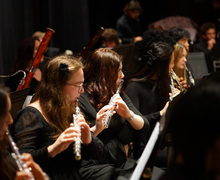Gil Rocha’s ‘The Border is a Weapon’ explores the border’s impact on Mexican-Americans
Maxine Brackbill | Photo Editor
Gil Rocha's exhibit "The Border is a Weapon" features illustrations and photographs of life around the United States and Mexico border. The exhibit explores the unification of cultural diversity in regions surrounding the Rio Grande valley.
Get the latest Syracuse news delivered right to your inbox.
Subscribe to our newsletter here.
A cascade of western boots hangs above a trail of soil, while illustrations and photographs of life around the United States and Mexico border cover the walls of the “The Border is a Weapon” exhibit. Artist Gil Rocha curated the collection as part of the Symposium’s “Landscapes” theme for the 2023-24 year, which he’s set to discuss with Juan Juarez, an associate professor in the School of Art.
“‘Landscapes’ events this year explore diverse interpretations of this concept, including the Constitution, border politics, Haudenosaunee ceramics (via an exhibit focused on the work of Peter B. Jones), minority youth and digital technology, environmental justice and reproductive rights,” said Vivian May, director of Syracuse University’s Humanities Center.
Rocha works at Laredo Arts Center in Laredo, Texas, and will be joined at the talk by a collective of Laredo-based artists. The show explores the unification of cultural diversity in regions surrounding the Rio Grande, despite the river’s geographic separation between Texas and Mexico.
“The artists that are collectively working together for this exhibition, their idea was to show that the border is this cultural crossover that forms the identity of who we are as Mexican-Americans,” Juarez said. “For Syracuse, it’s important for the university and the public at large to see that bigger picture of what it means to be a Mexican-American born and raised on the border.”
The area between Laredo and Nuevo Laredo used to be somewhat permeable and allowed for more frequent travel from Mexico to the United States, Juarez said. In more recent years, however, it has become a highly militarized zone which imposes upon those who do not live on the border with an “us against them” mentality.
It is the goal of Rocha and the artist collective to dismantle this mindset and further emphasize the border as a cultural crossover, one that shapes the identities of thousands of Mexican-Americans.
“(The exhibit is) a very interesting take on not only cultural identity but also the ways in which artists work,” Juarez said. “The term we like to use in relation to that is ‘rasquachismo’ which is a term coined in Chicano philosophy. It’s this idea of mish-mashing and putting together things from all over the place.”
Rocha is intentional in his use of the words “border” and “weapon.” The title is up to interpretation by the general public, but for Rocha, it also refers to the borders that society creates and maintains, which he expressed through his artistic statement.
His exhibit aims to identify moments to connect with national and personal identity and better understand the state of our world.
“Political processes, all of the economic and migratory exchanges that happen at the border are one of the most important things in U.S. politics, overall,” said Matt Cleary, Associate Professor of political science in the Maxwell School of Citizenship and Public Affairs. “An exhibit like this can inform people and raise awareness of what the border is like.”
Cleary, whose areas of concentration include Mexican politics and Latin American culture, also noted how most Americans do not have a good understanding of the politics and relationship between Mexico and the United States because of how the border is covered in the media. Rocha’s exhibition will give voice to other people’s experiences with borders, highlight how borders are being redefined and create a spirit of pride.
“Our nation’s southern border, as with our northern border, has a distinct history,” May said. “It is a contested space and the cultural and artistic work that teases out these particularities, as Gil Rocha’s work does, touches all of us.”
Published on September 26, 2023 at 6:57 pm






